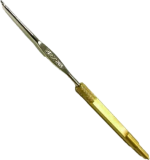Auto Doc's
Lawn Addict
- Joined
- Sep 7, 2024
- Threads
- 20
- Messages
- 1,825
Hello Folks,
Carburetor cleaning can be a chore, but sometimes it takes more than just good carburetor cleaning and a round in the ultrasonic bath. I try to save what carburetors I can to avoid aftermarket copycat versions.
For those that hate Nikki carburetors, I will simply say don't open them unless you put a complete rebuild kit in them. I work on many mower carburetors, but also ATV and automobile carburetors. I've been rebuilding them for many years. But, once in a while I run into one that will give me headaches.
Last week I was working on a problem carburetor on a 2003 Honda Rancher 350 ATV, and it was giving me fits. It has a press in needle seat. No matter how I adjusted the float level it would eventually spring a leak at the bowl overflow.
Finally, I got online to check out some of The You Tube videos and a guy brought up and interesting procedure for cleaning the needle seat and polish it in these ATVs.
Over time gasoline develops a resin or shellac and that stuff is difficult to remove even with the best carburetor cleaner. The solution he came up with was to use a Q-tip with the carb spray. Insert the Q-tip cotton tip into the seat and gently spin it. It cleaned and polished the seat perfectly.
It worked great and I had no more needle leak problems.
Hope this helps someone.
I don't think this same method would work on any 2-stroke handheld carburetor because the parts are way too small.
Carburetor cleaning can be a chore, but sometimes it takes more than just good carburetor cleaning and a round in the ultrasonic bath. I try to save what carburetors I can to avoid aftermarket copycat versions.
For those that hate Nikki carburetors, I will simply say don't open them unless you put a complete rebuild kit in them. I work on many mower carburetors, but also ATV and automobile carburetors. I've been rebuilding them for many years. But, once in a while I run into one that will give me headaches.
Last week I was working on a problem carburetor on a 2003 Honda Rancher 350 ATV, and it was giving me fits. It has a press in needle seat. No matter how I adjusted the float level it would eventually spring a leak at the bowl overflow.
Finally, I got online to check out some of The You Tube videos and a guy brought up and interesting procedure for cleaning the needle seat and polish it in these ATVs.
Over time gasoline develops a resin or shellac and that stuff is difficult to remove even with the best carburetor cleaner. The solution he came up with was to use a Q-tip with the carb spray. Insert the Q-tip cotton tip into the seat and gently spin it. It cleaned and polished the seat perfectly.
It worked great and I had no more needle leak problems.
Hope this helps someone.
I don't think this same method would work on any 2-stroke handheld carburetor because the parts are way too small.

